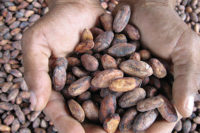 What entices each bite of a mini salted-maple, toasted-almond Cronut—as I recently relished at Donut Savant in Oakland, CA—the flaky tenderness of fried laminated dough, with sweet-salty creamy frosting countered with crunchy texture from the aromatic, slivered almonds?... It triggers sensory pleasure, dopamine-fired, each little bite inspired.
What entices each bite of a mini salted-maple, toasted-almond Cronut—as I recently relished at Donut Savant in Oakland, CA—the flaky tenderness of fried laminated dough, with sweet-salty creamy frosting countered with crunchy texture from the aromatic, slivered almonds?... It triggers sensory pleasure, dopamine-fired, each little bite inspired.
The key here is dynamic contrast, and as I note in this month’s Market Trends article, the concept forever remains an instrumental catalyst in the pleasure of food.
Chefs have known this nebulous truth for years, but Steven Witherly—along with Bob Hyde—was the first, back in 2007, to name it. In “Why Humans Like Junk Food,” we find Witherly and Hyde’s Theory of Dynamic Contrast. It explains why people maintain a preference for foods with sensory contrasts like light and dark, sweet and salty. Witherly calls it the “ping-pong pleasure,” as we delight in point and counterpoint—or perhaps a sudden, magnificent tapestry of sensory emotion.
Even foods that call for a sublime purity revel in a carefully cultivated set of distinguishing, signature characteristics: An identifying sourdough earthiness that anticipates a baguette’s toothsome crust and supremely tender crumb. The sandwich cookie’s bag-cracked waft of subtle cocoa followed by vanilla-scented dairy creaminess, anticipating that first delightful bite. The sweet sensory hit boosted by saltiness that precedes the lingering burn signature to today’s omnipresent sriracha, accenting a wide range of snacks.
These are the dynamics that drive repeat purchase. We seek identification with the flavor-fed resonance we’ve found. We discover that we know what we like. And we want more of it.
I just participated in a culinary trend tour of Oakland, CA, and I left with the impression that Oakland is a microcosm of American food today. It’s an incubator of a surprisingly wide spectrum of culinary avenues leading to a tomorrow that pushes boundaries, creates—and revels in—our undeniable emotional ties to food, simultaneously challenging and comforting. It surprises, yet coast-to-coast we anticipate each bite. It defies class, celebrates uniqueness and innovation, finds our middle ground, and strengthens community. Its fringes invigorate and excite, and the core hits dead center. And it’s just plain delicious.
But every culinary current holds more than meets the eye. The play painstakingly crafts brilliance behind the scenes to present seamless magic onstage. Oakland wasn’t built in a day. Finding just the right balance between salt and maple takes time and patience. And just the right ingredient can make a world of difference.
In this issue, we celebrate (among other things) figs and almonds, chiles and cardamom, salt and caramel. Sweet-savory explorations find their best expressions through surprising harmony. And maintaining a keen ear to the ground of your supply chain can do wonders for your sense of innovation.
Consider figs. Whole, they’re artistically divine. But then look into diced, paste, powder and juice concentrate and the curtain lifts. Consider almonds—and then understand sliced, slivered, diced, meal, flour and milk. And then frame your thoughts in roasted, toasted, blanched and caramelized. Synergistically combine, and 1 + 1 = 3. A world of possibility unfolds.
A wealth of potential avails itself once we arm ourselves with the knowledge that feeds innovation. And each ingredient can potentially catalyze the dynamic contrast that regularly scans a SKU or brings customers through the door.
Step outside your comfort zone and explore. A dynamic world of opportunity awaits.





